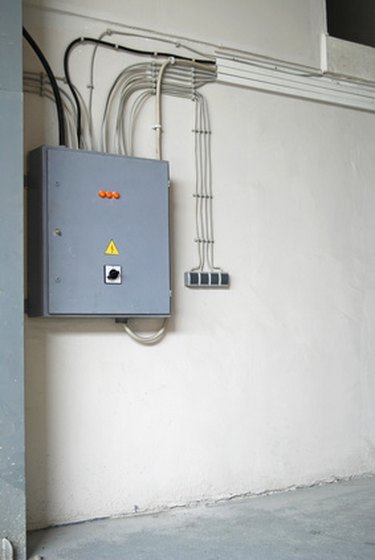Things You'll Need
Insulated screwdriver
Hammer
Cable clamps
Slip-lock pliers
Utility knife
Wire strippers

An important procedure when remodeling a house is updating the electrical circuitry. You may need extra circuits if you are adding more living space, or you may need to change the circuits you have to accommodate different lighting or a new configuration of appliances. Changing the circuitry presents the need for making modifications in the electrical panel, sometimes called the breaker box. As long as you don't require a larger panel as a result of your changes, you can readily rewire the existing one. Do so with care, however, to avoid serious injury.
Step 1
Open the cover of the panel and turn off the main breaker. Unscrew the cover plate and remove it to expose the wiring inside. Exercise caution. Even though turning off the main breaker cuts power to all the circuits, it does not de-energize the hot (brass) bus bars. Keep your hands and tools away from them at all times.
Video of the Day
Step 2
Remove the breakers connected to circuits that are no longer functioning as a result of your modifications, or that you want to change. Insert the tip of the screwdriver between the end of the breaker further from the bus bar and the back of the panel and pry the end up. When you can grip the breaker with your fingers, pull it up and unsnap it from the bus bar.
Step 3
Unscrew the lug inside the breaker and remove the black or red wire, then bend the wire away from the panel and set the breaker aside. Remove the white wire from the same cable as the one you just removed from the neutral (silver) bus by loosening the lug that holds it and pulling it out. Remove the bare ground wire from the ground bus in the same way.
Step 4
Unscrew the clamp on the side of the panel holding that circuit cable and pull the cable out of the panel if it is no longer in use. Leave it in place if you have altered the circuit and you simply need to upgrade the breaker.
Step 5
Knock out holes on the side of the panel with a hammer and screwdriver if you need to feed in more circuit cables. Attach a cable clamp to each hole by inserting the threaded end into the box and tightening on a nut with a pair of slip-lock pliers. You can feed as many cables through a clamp as will fit. Tighten the clamp with a screwdriver when you have finished feeding wires through it.
Step 6
Connect a cable to the panel by stripping 6 to 10 inches of sheathing off it with a utility knife and exposing 1/2 inch on the ends of the insulated wires with a wire stripper. Feed the white wire into an available lug on the neutral bus and the bare wire into a lug on the ground bus. Tighten the lugs with a screwdriver. Feed the black wire into the lug of a circuit breaker, tighten the lug and snap the breaker into an available slot on the hot bus.
Step 7
Size the breaker for each circuit according to the expected load. Circuits servicing lights or light-duty outlets generally require 15-amp breakers, while most other circuits require 20-amp breakers. Circuits on a 20-amp breaker must be wired with 12-gauge cable, but you can use lighter 14-gauge cable for 15-amp circuits.
Step 8
Use a double-gang breaker for each 240-volt circuit, connecting the red wire from the circuit cable to one breaker and the black wire to the other. A double-gang breaker is actually two breakers connected together so that if one trips, the other trips with it. Each 240-volt appliance should be wired with 10- or 8-gauge cable and be on a dedicated circuit with its own breaker.
Step 9
Label each circuit as you connect it to the panel. This is an important step that will save you much confusion in the future.
Step 10
Screw the cover plate back onto the panel when you have made all the connections and turn the main breaker back on.
Tip
In the interest of safety, have your work checked by a licensed electrician for possible hazards and code violations before you turn the power back on.
Warning
The electrical code requires all your house circuitry to be grounded. If you have an old, ungrounded panel, replace it with one that has a ground bus and ground it properly before rewiring your circuits.
Wear rubber-soled shoes and rubber gloves while working in the panel to protect yourself in case a tool slips and contacts one of the hot bus bars.
Video of the Day